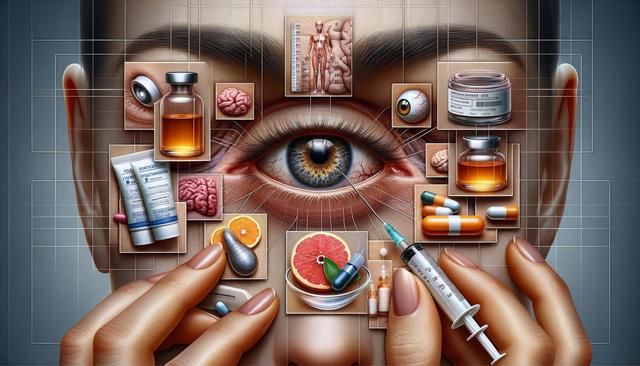Understanding the Causes of Eye Bags and Dark Circles
Eye bags and dark circles are common cosmetic concerns that affect a wide range of individuals. While often used interchangeably, they stem from different causes. Eye bags typically refer to swelling or puffiness under the eyes, often due to fluid retention, aging, or lack of sleep. Dark circles, on the other hand, may result from pigmentation, thinning skin, or underlying blood vessels becoming more visible.
Several factors contribute to the appearance of eye bags and dark circles:
- Aging, which can lead to the weakening of tissues and muscles around the eyes
- Genetics, as some people are more predisposed to develop them
- Sleep deprivation and fatigue
- Allergies or sinus issues, which can cause blood vessels under the eyes to dilate
- Poor hydration and high salt intake, leading to water retention
Understanding these causes is crucial in determining the most appropriate treatment approach. Consulting a licensed dermatologist or medical professional can provide personalized guidance based on individual skin type and health factors.
Topical Treatments and Skincare Approaches
One of the most accessible treatment options for eye bags and dark circles is the use of topical skincare products. These are often formulated with ingredients that help reduce puffiness, improve skin texture, and lighten pigmentation. For instance, caffeine-based creams can help constrict blood vessels and reduce swelling, while ingredients like vitamin C and retinol promote collagen production and brighten the under-eye area.
Common topical ingredients that may help include:
- Hyaluronic acid – to hydrate and plump the skin
- Peptides – to support skin structure and firmness
- Niacinamide – to improve skin tone and reduce pigmentation
- Vitamin K – to improve blood circulation and reduce discoloration
Consistent use of these products, often in combination with gentle massage or cooling applicators, can lead to visible improvements over time. However, results vary depending on the severity of the condition and individual skin response.
Non-Invasive Medical Procedures
For those seeking more immediate or noticeable results, several non-invasive and minimally invasive treatments are available at dermatology clinics or cosmetic centers. These procedures are designed to reduce puffiness, stimulate collagen production, or improve pigmentation issues in the under-eye area.
Popular non-invasive options include:
- Laser therapy – helps resurface the skin and reduce pigmentation
- Microneedling – stimulates collagen and improves skin texture
- Radiofrequency treatments – tighten and firm the skin
- Chemical peels – lighten dark circles caused by hyperpigmentation
These treatments often require multiple sessions for noticeable effects and should be performed by experienced professionals. It is important to discuss your medical history and expectations with a qualified provider to ensure the treatment aligns with your goals and skin condition.
Injectables and Surgical Options
When topical and non-invasive treatments are not sufficient, injectables or surgical procedures may be considered. These options are typically chosen for more pronounced eye bags or significant under-eye hollowing, often due to aging or genetic factors.
Some of the available medical treatments include:
- Dermal fillers – used to fill in hollows and smooth the under-eye area
- Fat transfer – involves using the patient’s own fat to restore volume
- Blepharoplasty – a surgical procedure to remove or reposition excess skin and fat
While these procedures can offer longer-lasting results, they also come with higher costs, potential risks, and recovery time. Consulting a board-certified plastic surgeon or dermatologist is essential to evaluate suitability and discuss the benefits and limitations of each method.
Lifestyle Adjustments and Preventive Measures
In many cases, simple lifestyle changes can help reduce or prevent the appearance of eye bags and dark circles. Prioritizing healthy habits not only supports overall well-being but can also improve skin health and appearance around the eyes.
Effective preventive strategies include:
- Getting adequate sleep (7–9 hours per night)
- Managing stress through relaxation techniques
- Reducing salt intake to prevent fluid retention
- Staying hydrated throughout the day
- Using sunscreen and wearing sunglasses to protect against UV damage
Additionally, using a cold compress or chilled eye mask in the morning can help reduce puffiness by constricting blood vessels. Elevating your head while sleeping may also prevent fluid buildup under the eyes. These small adjustments, when practiced consistently, can contribute to noticeable improvements over time.
Conclusion: Choosing the Right Approach
Treating eye bags and dark circles effectively often requires understanding the root cause and exploring a combination of lifestyle changes, skincare products, and professional treatments. While some individuals may benefit from simple at-home remedies, others may require advanced procedures to achieve their desired results. A personalized approach—ideally guided by a skincare or medical professional—can help ensure safe and effective outcomes. Whether you’re addressing early signs or more persistent concerns, taking consistent, informed steps is key to improving the appearance of the delicate under-eye area.




Leave a Reply